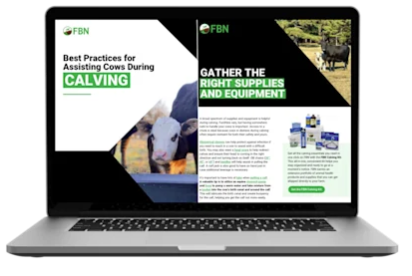How to Start Newborn Calves Strong
Thursday, March 13, 2025
Reference: Farmers Business Network
 To say it all starts with newborn calf care is not an overstatement. Getting a calf started off strong and healthy sets it up for maximized growth and a solid weaning weight.
To say it all starts with newborn calf care is not an overstatement. Getting a calf started off strong and healthy sets it up for maximized growth and a solid weaning weight.
The new guide Best Practices for Assisting Cows During Calving teaches you how to deliver the calf more easily and how to prevent respiratory diseases and scours once it's born, as well as provides three treatment options for providing postpartum care to your cow. Download it for free here.
Continue reading below to get calf care tips and see the essential calving supplies that will help you be prepared this season.
The 5 Basic Steps of Newborn Calf Care
1. Get the Calf Warm and Dry
The mother should be able to dry and warm the calf by aggressively licking, but sometimes additional equipment like a warming box will be helpful. This will give you a place that is dry and warm for the newborn calf and will help protect it against the cold.
2. Dip Navel with Iodine
Dipping the navel with iodine will help reduce infection through the open umbilical cord, which can take a day or two to dry up and fall off. The umbilical cord goes straight to the liver so the potential for a calf to get systemically sick is very high if it becomes infected.
If a cow licks off the iodine aggressively, you may want to consider skipping this step. In some cases, the cow licking the navel can cause infection. Discuss your options with your veterinarian. If you do decide to skip this step, ensure that you have a nice dry and bedded area for the calf to rest.
3. Administer Vaccines
Scour vaccines and/or respiratory vaccines are good tools to protect your calf from disease. Discuss a protocol with your veterinarian that fits your operation.
_________________________________________________________________________________________________________________
FBN makes it easy to order prescription animal health products online for delivery to your ranch. Get step-by-step instructions here.
_________________________________________________________________________________________________________________
4. Consider Castrating Bull Calves
Veterinarians often advise that castration should take place when calves are young because it’s less painful, less stressful, and the likelihood of a bull calf bleeding out is reduced because they’re smaller. Discuss the timing and pain management with your veterinarian.
5. Let Mama and Baby Nurse
Ideally, calves should be up and nursing within 30 minutes of birth. This is necessary for the calf to get a full feeding of colostrum within 6 hours to get passive transfer of their immune system.
Essential Newborn Calf Supplies
Read more
Sign up to stay connected
- News
- Property Alerts
- Save your favourite properties
- And more!
Joining Farm Marketer is free, easy and you can opt out at any time.
